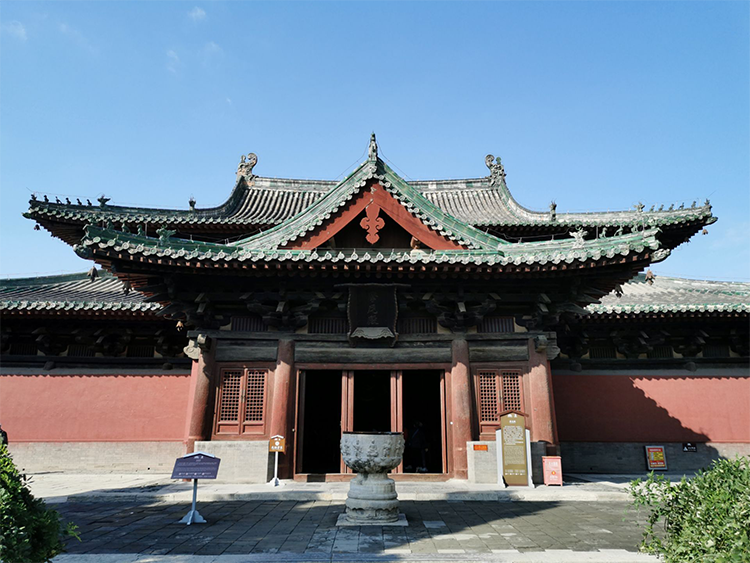Longxing Temple: Explore Chinese Buddhist Art in a Song Dynasty Masterpiece
Introduction
At dawn, gilt roof ornaments shimmer like ripples while a 21-meter-tall Thousand-Armed, Thousand-Eyed Guanyin gazes gently at pilgrims who have come through the centuries. Longxing Temple in Zhengding is far more than a temple—it’s a three-dimensional textbook of Song dynasty architecture. Architectural historian Liang Sicheng visited and surveyed it three times, calling the Mani Hall “a unique example in China.” Touch the worn strokes on the Sui stele and you can almost hear the chisels from the temple’s founding in 586.
1. Chinese Architectural Living Fossil: Cross-Shaped Halls and a Timeless Dialogue with the Thousand-Armed Guanyin
Longxing Temple’s charm lies in its exceptional preservation of 10th–12th century structures along the central axis:
– Mani Hall built 1052, Northern Song): Its cruciform dome opens like a mandala. The hall’s four projecting apses are one of only three surviving examples worldwide; Liang Sicheng highlighted its rarity. Inside, a Ming-era inverted-seated Guanyin—hailed by Lu Xun as an “Oriental beauty goddess”—sits with a nonchalant, almost playful posture.
– Great Compassion Pavilion : Home to the Northern Song bronze Thousand-Armed, Thousand-Eyed Guanyin cast in 971 (Kaibao 4). The hollow torso once held Song-era sutras and offering objects; 42 of the statue’s arms hold different ritual implements.
– Rotating Sutra Pavilion : An octagonal wooden sutra cabinet that can rotate 360 degrees—an ancient embodiment of the “turning Dharma wheel.” It is arguably the world’s oldest rotating bookcase.
2. Civilization Encoded in Stone: The Longzangsi Stele
Under glass before the precepts platform stands the Longzangsi Stele . Its regular-script strokes are carved with a knife-like precision, making it both a witness to the temple’s origins and a milestone in the evolution of Chinese calligraphy. Scholars trace stylistic lines here back to masters like Ouyang Xun and Yu Shinan. The worn edges and rubbing marks are time’s own fingerprints.
3. Immersive Zen Experiences — How to Feel the Temple
– Morning Bell and Evening Drum: The early service opens to visitors at 05:30. Monks chant the Diamond Sutra, and the recitation reverberates through the halls.
– Lamp Offering and Blessings: Lotus lamps are available at the circulation window on the east side of the Great Compassion Pavilion (20 yuan each). Rows of lamps form a radiant “star river” that complements the bronze Guanyin’s gleam.
– Vegetarian Meal Experience: In the temple kitchen, try the Arhat Noodles (15 yuan), kneaded with water from the ancient well and flavored with shiitake and dried bamboo shoots—simple, grounding, and unexpectedly enlightening.

4. A Pilgrimage for Architecture Lovers
In 1933 Liang Sicheng’s hand-drawn measurements of the Mani Hall shocked the architectural world—revealing layered dougong (bracket sets), protruding eaves with four-meter overhangs, and craft techniques recorded in the Yingzao Fashi but largely lost elsewhere. Photographers: schedule a session around 4:00 PM; the slanted western light turns the bracket shadows against the red walls into cinematic silhouettes.
5. Practical Tips: Be a Prepared Visitor
– Getting There: From Shijiazhuang, take Metro Line 1 to Convention Center Station (Exit D), then transfer to Sightseeing Line 2 to Longxing Temple station. Total travel time about 50 minutes.
– Tickets: 50 yuan (includes an audio-guide deposit). Buying tickets via QR code helps avoid long holiday lines.
– Etiquette and Restrictions: No flash photography of statues. When circumambulating a buddha, move clockwise.
– Hidden Bonus: In the rear courtyard of the Great Compassion Pavilion stands a millennia-old locust tree; one burl naturally resembles a “Buddha’s hand” motif.

Conclusion
Shielded from modern noise by nine bays of deep eaves, Longxing Temple preserves the Tang–Song aesthetic of “entering an ancient temple at dawn, first sunlight on tall woods.” It is at once a laboratory for architectural study and a quiet field of energy where visitors can find inner calm—perhaps just as the smiling inverted Guanyin implies: true wisdom can be found in turning to see the path behind you.


